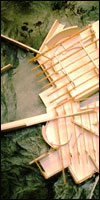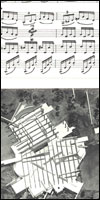 |
||||||
 |
||||||
|
M.I.T. Design Thesis on Music and Architecture Niccolo Casewit was awarded the MIT School Medal in 1987 for his work on the synesthetic relationship of music and architecture. M.I.T. Architecture Design Thesis: “Related Explorations in Architectural and Musical Composition” Design Thesis Abstract: Architecture has been described as “frozen music.” To be sure, architecture has many physically static features, yet- it can be best understood as a process in motion and as motion. Both architecture and music share attributes of qualitative movement. A composition unfolds in phases of tension and repose, extension and arrival. Explicit patterns of organization are defined by proportions, gradients of texture and intensity, and always through experience of space and time. Musical Scores of original Violin Sonata, Recorded Pserformances, Architectural Drawings and Model Photos are included in the thesis accepted in partial fulfillment for the degree of Master of Architecture at M.I.T. Description of the Site Design: The most private and secluded buildings are positioned deep in the forested areas of the site; the studios are thus imbedded into the small openings we call “foreground” They are readily accessible from existing paths which punctuate the unarticulated hiss of the forest. The studios are highly dispersed within the site and are in themselves self-contained and elevated as treehouses above the forest floor—exemplifying the the individual and meditative nature of the artistic work which will transpire within them. Site walls and ground forms are long continuous elements which provide “background” definitions to the site as a whole. The ground forms follow the fall-lines of the slopes and give both lines of reference to the structural goals in the landscape. Concert Hall, Exhibition Space and Restaurant and workshops comprise the larger public buildings. Most accessible the buildings are grouped collectively at the forest edges which outline the historic apple orchard fields of the Brooksby Farm near Peabody , Massachusetts . Thesis Conclusion: Translating Landscape, Music, and Architecture is not possible; even it were, it is not valuable or relevant because their forms and materials are different. Nonetheless we think making descriptive comparisons is a fruitfull working method. Composing in layers and with movement in mind is useful because it inspires and illustrates a way of thinking which is common to all art forms… Thesis Supervisor: William Lyman Porter, Professor of Architecture and Planning, Architect and Pianist Thesis Readers: Shun Kanda and Fernando Domeyko-Perez, both Architects; David Epstein, MITSO Conductor and Composer.
|
|||||||||||||||||||||||||||||||


